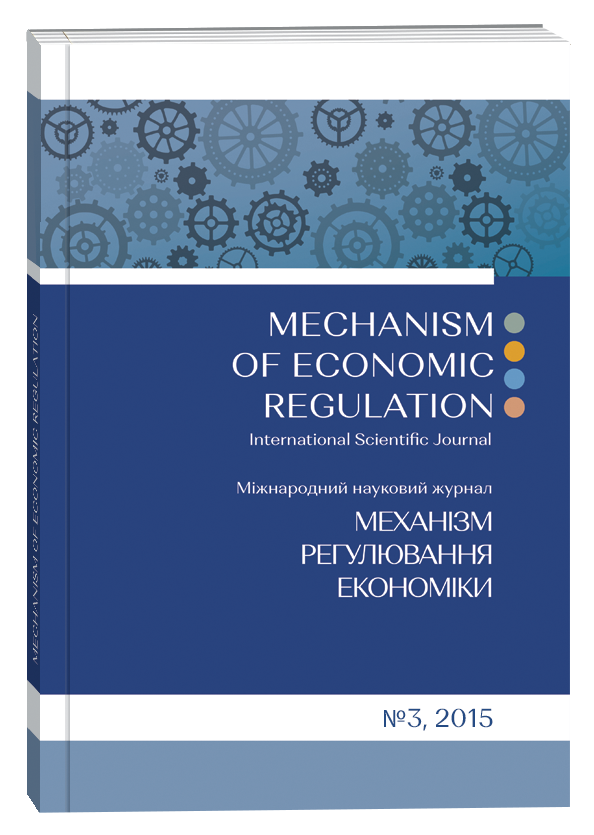INSTITUTIONAL GENOTYPE CONCEPT ANALYSIS
Abstract
In this article the concept of institutional genotype is proposed taking into account reason-consequence connections and genetic relations in economical systems based on institutional, social-economical, evolutionary, and cultural factors. The category of institutions is researched in comparison with «genotype» in borders of organizational structure «phenotype» which is formed in evolution as the result of society genotype ancestral attributes interaction and institutional medium conditions. The similarity of institutions to genes and the mechanism of their development, copying, and the ways they influence individuals and organizations are analysed. Attention is concentrated on the fact that the socio-economic development and institutional changes are different in many aspects. This is due to a mismatch of the processes occurring in these systems. For a more thorough understanding of the concept of institutional genotype, the vertically-tier structure was analysed and «kleptocratic institutional genotype» was investigated, which dominates in the economy of Ukraine.
References
Майминас, Е. З. О русском генотипе. Куда идет Россия? / Е. З. Майминас // Социальная трансформация постсоветского пространства. – М. : Аспект–Пресс, 1996. – С. 292–299.
Лемещенко, П. С. Экономическая ментальность и рыночная реформа в Беларуси / П. С. Лемещенко, А. М. Сидорова // Европейский вектор экономического развития: С.бк науч. трудов. – Днепропетровск, 2012. – Вып. 2 (13). – С. 518–523.
Митрофанова, Ю. Н. К проблеме дефиниции ментальности в культурной антропологии / Ю. Н. Митрофанова, В. А. Спирин // Европейский журнал социальных наук. – 2014. – № 4 (43), – Том 2. – С. 8–10.
Бондаренко, И. А. Последствия трансформации институциональной среды домохозяйств в России / И. А. Бондаренко // Научные труды ДонНТУ. Серия Экономическая. − 2013. – № 3 (45). – С. 155–159.
Гайдай, Т. Інституційна теорія: дослідження економічної ментальності / Т. Гайдай // Економіка. – 2007. − Випуск 93. – С. 4–6.
Мартишин, Е. М. Генотипические механизмы эволюции экономической системы / Е. М. Мартишин // Terra Ekonomicuc. – 2011. – Том 9. – № 3, Часть 2. – C. 7–8.
Нельсон, Р. Эволюционная теория экономических изменений / Ричард Р. Нельсон, Сидней Дж. Уинтер. – М. : Финстатинформ, 2000. – 474 с.
Paavola, J. New Institutional Economics and the Environment: Conceptual Foundations and Policy Implications /Jouni Paavola, W. Neil Adger. – London : Centre for Social and Economic Research on the Global Environment, 2002. – 31 p.
Hodgson, G. Dismantling Lamarckism: why descriptions of socio-economic evolution as Lamarckian are misleading / G. M. Hodgson, T. Knudsen // Journal of Evolutionary Economics. – 2006. – № 16. – Р. 343–366.
Kingston, C. Comparing Theories of Institutional Change / Christopher Kingston, Gonzalo Caballero // Journal of Institutional Economics. – 2009. – Volume 5, Issue 02. – Р. 151–180.
Вольчик, В. Проблема отбора: рынки и институты в экономической теории / В. В. Вольчик // Экономический вестник Ростовского государственного университета. – 2005. – Том 3, № 4. – С. 47–54.
Хайек, Ф. Пагубная самонадеянность. Ошибки социализма / Ф. Хайек. – М. : Новости, 1992. – 304 с.
Hodgson, G. What Are Institutions? / Geoffrey M. Hodgson // Journal of Economic. – 2006. – № 1, Vol. ХV. – Р. 15–25.
Gorodnichenko, Y. Culture, Institutions and Decoratization / Yuriy Gorodnichenko, Gerard Roland. – Cambridge : NBER, Working paper 21117, April 2015. – 21 р.
Нисневич, Ю. Многоликая коррупция и ее измерения в исследованиях международных организаций и международных отношений / Ю. Нисневич, Д. Стукал // Мировая экономика. –2012. – № 3 – С. 83–90.
Majmynas, E. Z. (1996), About Russian genotype. Whither Russia? Moscow, Aspekt-Press. (In Russian)
Lemeshchenko, P. S. & Sydorova, A. M. (2012), “Economic mentality and market reforms in Belarus,” Yevropeyskiy vektor ekonomichieskoho razvitiha, 2 (13), 518–523. (In Russian)
Mitrofanova, Yu. N. & Spirin, V. A. (2014), “On the problem of the definition of mentality in cultural anthropology,” Evropeyskiy zhurnal sotsialnykh nauk, 4 (43), 2, 8–10. (In Russian)
Bondarenko, Y. A. (2013), “The consequences of the transformation of the institutional environment of households in Russia,” Nauchnyie trudy DonNTU. Seriia Ekonomicheskaia, 3 (45), 155–159. (In Russian)
Hayday, T. (2007), “Institutional theory: study the economic mentality,” Ekonomika, 93, 4–6. (In Ukrainian)
Martyshyn, E. M. (2011), “Genotypic mechanisms of evolution of the economic system,” Terra Ekonomicuc, 9, 3 (2), 7–8. (In Russian)
Nelson, R. & Winter, S. (2000), Evolutionary Theory of Economic Change, Moscow, Finstatinform. (In Russian)
Paavola, J. & Adger, W. (2002), New Institutional Economics and the Environment: Conceptual Foundations and Policy Implications, London, Centre for Social and Economic Research on the Global Environment. (In English)
Hodgson, G. & Knudsen, T. (2006), “Dismantling Lamarckism: why descriptions of socio-economic evolution as Lamarckian are misleading,” Journal of Evolutionary Economics, 16, 343–366. (In English)
Kingston, C. & Caballero, G. (2009), “Comparing Theories of Institutional Change,” Journal of Institutional Economics, 5 (02), 151–180. (In English)
Volchik, V. (2005), “The problem of selection: market sand institutions in economic theory,” Ekonomichieskiy viestnik Rostovskoho hosudarstvennoho univhersitieta, 3 (4), 47–54. (In Russian)
Hayek, F. A. (1992), The Fatal Conceit: The Errors of Socialism, Moscow, Novosti. (In Russian)
Hodgson, G. (2006), “What are Institutions?,” Journal of Economic, 1, Vol. ХV, 15–25. (In English)
Gorodnichenko,Y. & Gerard, R. (2015), Culture, Institutions and Democratization, Cambridge: NBER, Working paper 21117. (In English)
Nisnevich, Y. & Stukal, D. (2012), “The many faces of corruption and its measurement in the study of international organizations and international relations,” Mirovaia ekonomika, 3, 83–90. (In Russian)


